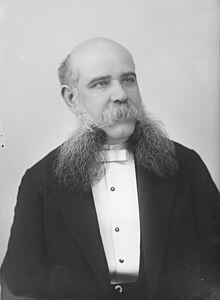Francisco de Paula Rius and Taulet
Francisco de Paula Rius i Taulet —known by some sources in contemporary Catalan as Francesc de Paula Rius i Taulet— (Barcelona, 1833-Olérdola, 1889) He was a Spanish lawyer and politician.
Declared a monarchist and liberal, he was mayor of Barcelona on four different occasions during the period of the Democratic Six-year period and the Restoration at the end of the XIX century . He was the main promoter of the Universal Exposition of 1888, which he presided over as mayor, and of all the urban reforms that Barcelona underwent on the occasion of the event.
Biography
The son of craftsmen, he studied Law at the University of Barcelona, and practiced law since 1858.
Of a monarchical and liberal orientation, he was elected mayor of Barcelona for the first time in February 1872 by Amadeo I. A year later, in February 1873, he left office before the advent of the First Spanish Republic.
After the coup in Pavía, he was appointed mayor again by General Serrano, occupying the position between January and December 1874.
Between March 1876 and June 1881 he was a deputy to Cortes for Barcelona on two occasions representing the Liberal Party.
He was appointed mayor of Barcelona for the third time in 1881, until February 1884, and for the fourth time between December 1885 and 1889.
As mayor of Barcelona, he was the main promoter of the Universal Exposition of 1888, which he presided over as mayor, and which constituted the most important urban and economic advance in the history of Barcelona up to that time.
Some of the improvements that were made in Barcelona under his mandate, and on the occasion of the 1888 Exposition were:
- Urbanization of the Ciudadela park, which after the end of the Expo became the largest park in the city.
- The urbanization of the whole front of the city was finished, between the park of the citadel and Las Ramblas, building the Paseo de Colón and a new spring: to the current Moll de la Fusta.
- The Grand Hotel International was built in a land won to the sea on the new Paseo de Colón, in front of the General Office building. The hotel, designed by the architect Lluís Domènech i Montaner, was built in the record time of 69 days. It had a floor and three floors, and it occupied a 5000 square meter plot. With capacity for 2000 guests, it was conceived as a temporary installation to welcome visitors. It was ruined after the end of the Exhibition.
- The Palau de Belles Arts was built (in Spanish, "Palace of Fine Arts"), next to the Parque de la Ciudadela, fell shortly after the Civil War. It was the place where the official opening of the Exhibition was held with the assistance of the Royal Family and also the headquarters of its closing in December 1888. It was intended for artistic exhibitions, concerts and cultural events. After the exhibition, it remained open until 1942.
- The Columbus Monument was built on the Portal de la Pau square, a point of union of the Paseo de Colón and the Rambla. The monument was opened on 1 June 1888, in the heart of the Exhibition.
- The area adjacent to the exhibition enclosure was urbanized in the Borne area.
- The Borne Market was opened between 1884 and 1886.
- "Las Golondrinas" was inaugurated, recreational boats that went out in front of the statue to Columbus and gave a promenade to visitors.
- Electric lighting was provided to the first streets of Barcelona (La Rambla, Paseo de Colón, Plaza de Sant Jaume and interior of the exhibition grounds).
In addition, he ceded the land for the construction of the Palace of Justice (1887-1908), built the southwest cemetery in Montjuic, created the Municipal Laboratory, the Municipal Hygiene Institute of Barcelona, as well as the Municipal Band and the Gallery of illustrious Catalans.
The Queen Regent María Cristina granted him the title of Marquis of Olérdola.
He died in Olérdola in 1889, at the age of fifty-seven, a few months after the end of the Universal Exhibition of 1888. His body was returned to Barcelona and buried in the Montjuic Cemetery.
On September 27, 1901, a monument was placed in his tribute in front of the main entrance to the Ciudadela park, built under his mayor's office. The monument bears the following inscription:
Rius and Taulet, being mayor of Barcelona, reached for the city prosperity and renown.Made in Spain the first Universal Exhibition held in 1888
and with enlightened initiative and untiring attitude, he protected the industry and exalted sciences and arts.
The main square of the Gracia district of Barcelona carried his name until April 19, 2009, when it was renamed, after a participatory process, as Plaza de la Villa de Gracia. Likewise, an avenue in the Barcelona district of Sants-Montjuich bears his name.
His son, Manuel Rius i Rius, was also mayor of Barcelona (from 1916 to 1917).
Personal background
The correspondence of Francisco de Paula Rius y Taulet that is conserved in the Historical Archive of the City of Barcelona contains 155 letters of which all but two are addressed to his colleague and friend Ramón Freixas Miret. Although the chronological period of the documents, 1856-1890, practically covers the professional and political career of Rius and Taulet, the content of the letters predominantly reflects legal matters and family and personal issues. Only some of them contain information related to the politician's activity and his impressions of the current political situation.
The fund was acquired at the public auction organized by Soler i Llach, Subastas Internacionales, S.A., in Barcelona, on March 9, 2006.

